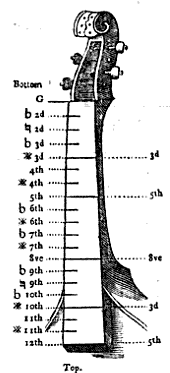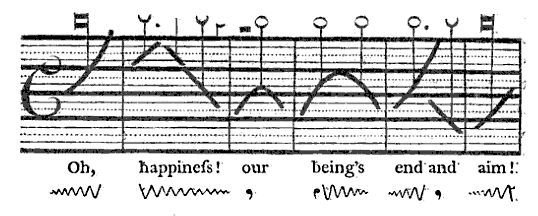"An essay towards establishing the melody and measure of speech"
Language Log 2016-03-22
In "Trump on China" (8/29/2015) we reproduced the Huffington Post's collection of Donald Trump' diverse performances of the word China. Last month, Iggy Jackson Cohen created a cover version on the bass guitar:
This reminded me of the technique that Joshua Steele used in his pioneering work An Essay Towards Establishing the Melody and Measure of Speech to be Expressed and Perpetuated by Peculiar Symbols, 1775. Steele begins with this prophetic sentence:
I had long entertained opinions concerning the melody and rhythmus of modern languages, and particularly of the English, which made me think our theatrical recitals were capable of being accompanied with a bass, as those of the antient Greeks and Romans were, provided a method of notation were contrived to mark the varying sounds in common speech …
And he goes on to propose such a method:
If the method, here essayed, can be brought into familiar use, the types of modern elocution may be transmitted to posterity as accurately as we have received the musical compositions of Corelli.
But perfection and accuracy in this art can only be attained by experience and a close attention, in estimating the pitch and extent of vocal slides by the ear, with the assistance of a proper instrument.
I hope, however, this example will shew, that the melody of speech is formed by slides and that by these, or some other apt characters, the musical expression of speech may be described and communicated in writing.
But if this essay be not sufficient to prove what the melody of speech is, let us, in the next place, endeavour to shew what it is not.
It is not like the proclamation of a parish-clerk announcing the psalm,

where the whole sentence is in one tone, without any change of acute or grave.

Neither is it like the intonation of the chorostates, or precentor in our cathedrals, where the change of tone is made between one sentence and another, or between one word and another; that is, where the change is made, not upon syllables, but upon words or sentences.

Now to submit these several examples to the judgement of common ears, let a bass viol have a paper pasted on the whole length of the finger-board near the 4th string, marking all the chromatico-diatonic stops or frets, suitable to that bass, from the bottom to the top, as in the figure represented below.
For the experiment of the slides, let the 4th string (though actually tuned to CC) be called G for the sake of keeping our slides within the compass of the five black lines, or nearly so; and also to keep the hand, making the slides, so high on the shift, as never to fall down to the open string.
 Then while the player draws the bow over the 4th string, let him try, by sliding his left hand on the same string up or down the finger-board, to imitate the rapid turns or flections of the voice in common speech, and he will soon find, that they will have either their beginnings or endings, for the most part, in the intervals between the fretts; which intermediate stops, we may call quarter tones : for it will be accurate enough for our purpose, to call every degree of tone a quarter, that does not coincide with any tone or semitone of the chromatico-diatonic. And then, if he can pronounce, being thus assisted by the instrument, all the foregoing examples, as they are written or noted, the auditors will most probably agree in the following conclusions.
Then while the player draws the bow over the 4th string, let him try, by sliding his left hand on the same string up or down the finger-board, to imitate the rapid turns or flections of the voice in common speech, and he will soon find, that they will have either their beginnings or endings, for the most part, in the intervals between the fretts; which intermediate stops, we may call quarter tones : for it will be accurate enough for our purpose, to call every degree of tone a quarter, that does not coincide with any tone or semitone of the chromatico-diatonic. And then, if he can pronounce, being thus assisted by the instrument, all the foregoing examples, as they are written or noted, the auditors will most probably agree in the following conclusions.
1st, That the sound or melody of speech is not, monotonous, or confined like the sound of a drum, to exhibit no other changes than those of loud or soft.
2dly, That the changes of voice from acute to grave, and vice versa, do not proceed by pointed degrees coinciding with the divisions of the chromatico-diatonic scale ; but by gradations that seem infinitely smaller (which we call slides); and though altogether of a great extent, are yet too rapid (for inexperienced ears) to be distinctly sub-divided; consequently they must be submitted to some other genus of music than either the diatonic or chromatic.
3dly, That these changes are made, not only upon words and upon sentences, but upon syllables and monosyllables. Also,
4thly, and lastly, That in our changes on syllables or monosyllables, the voice slides, at least, through as great an extent as the Greeks allowed to their accents; that is, through a fifth, more or less.
Applying his method to his own recitation of a line of verse, he gets
Or in a more compressed and abstracted notation:

And here's his own opinion about the "measure" part of "the melody and measure of speech", expressed in his own notation:
Read the whole thing. (There's also a "second edition amended and enlarged" from 1779.)
I wish I could say that we've made a lot of progress in the past 240 years. We do have much more accurate and convenient instruments for acoustic analysis, at least.

